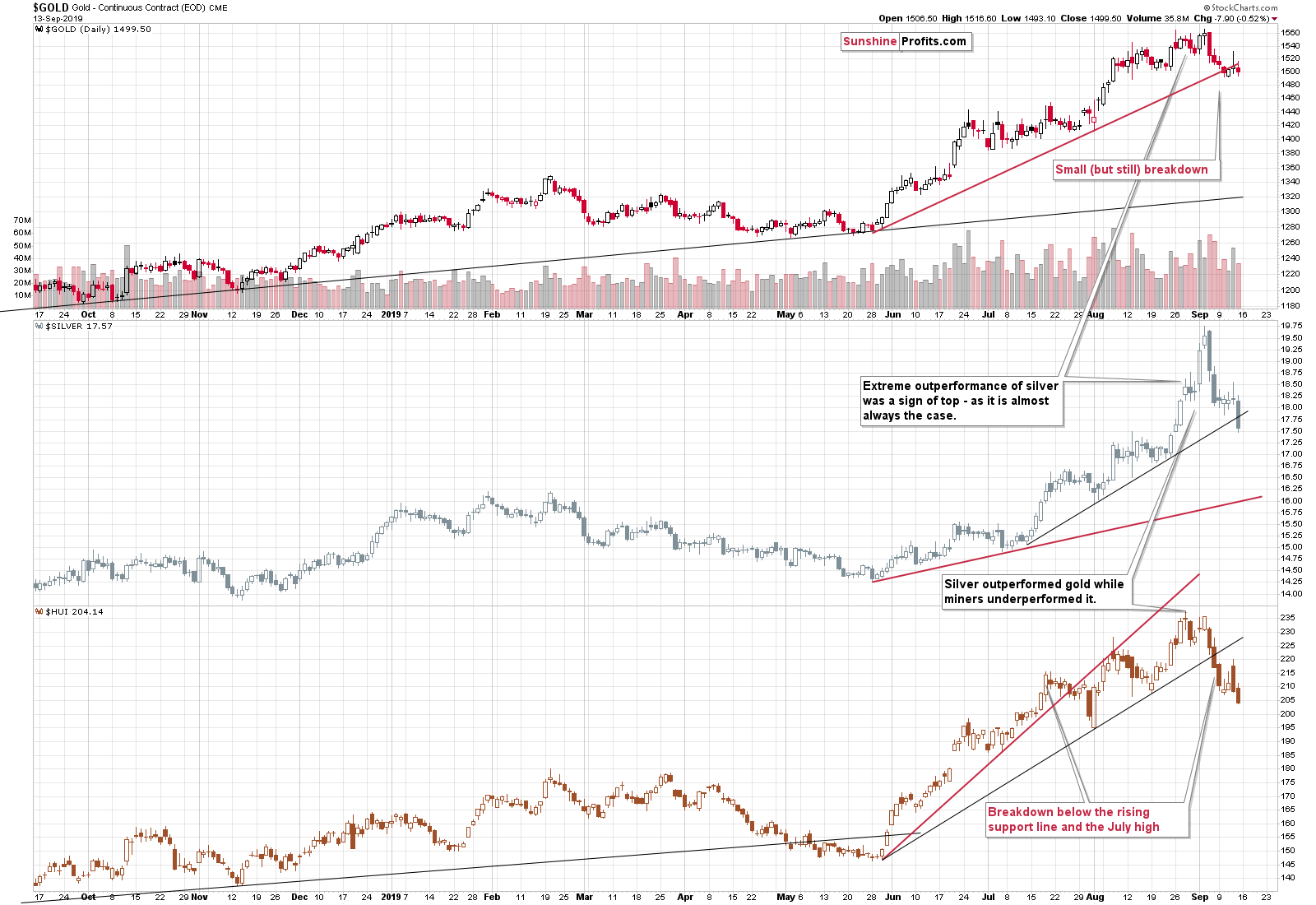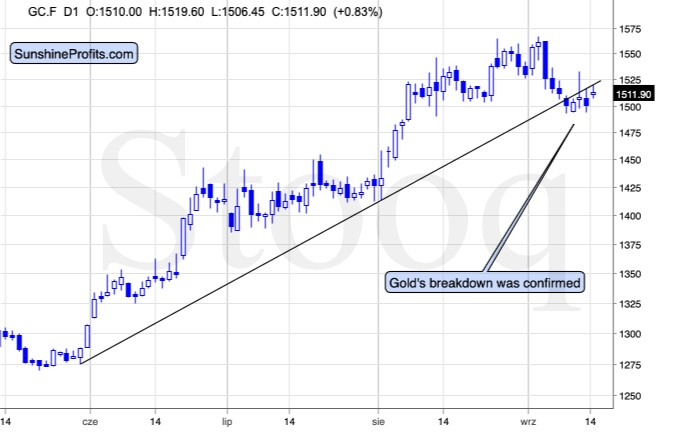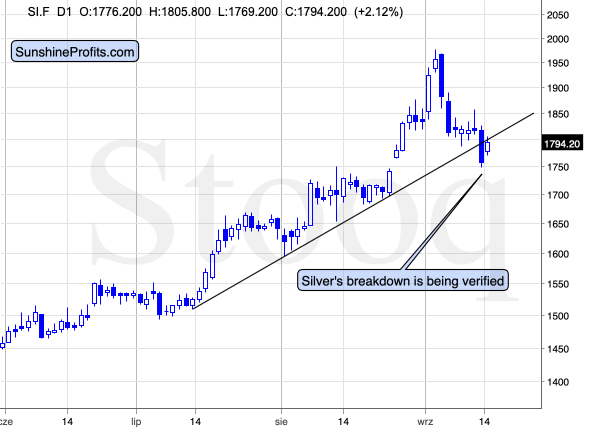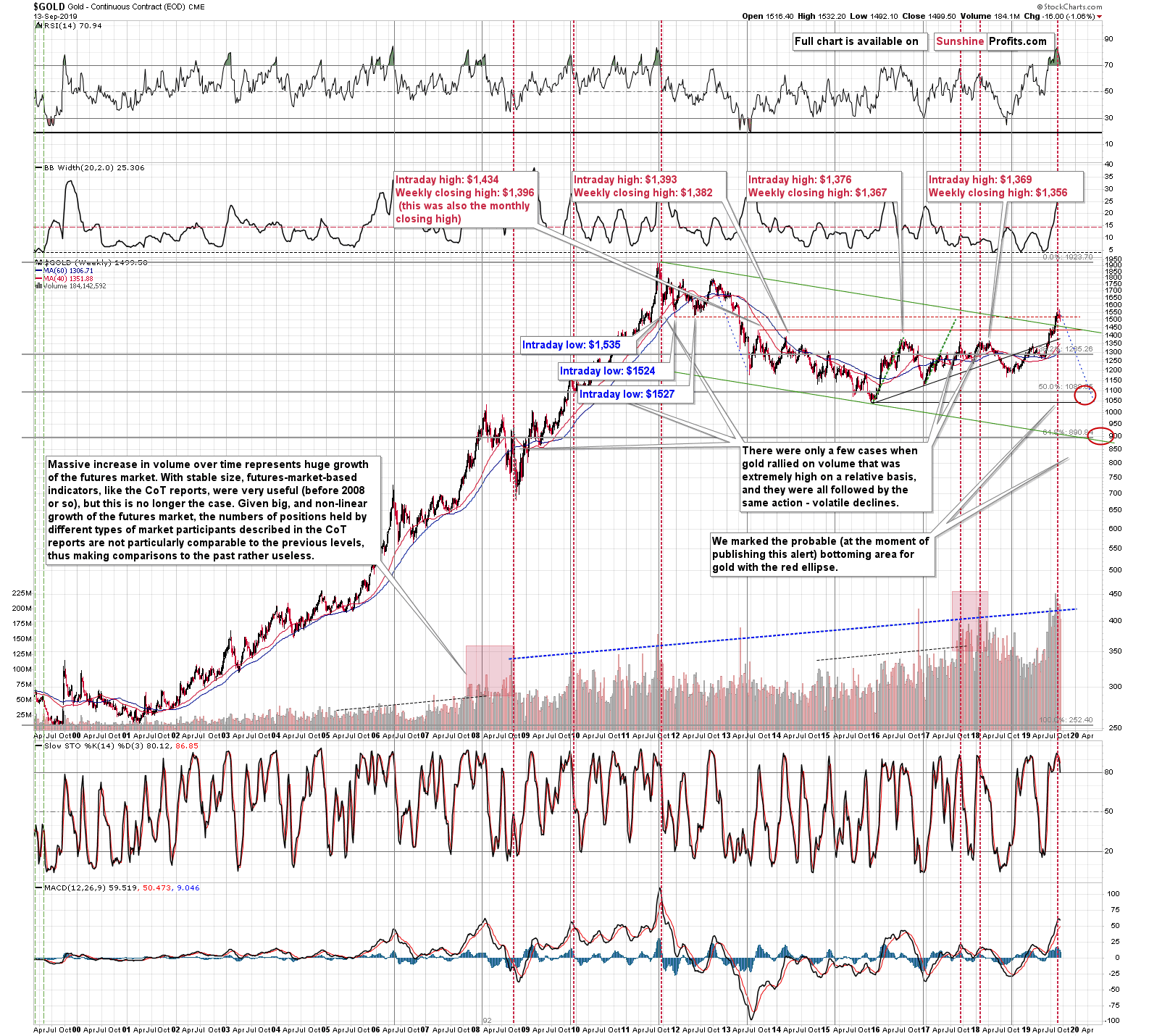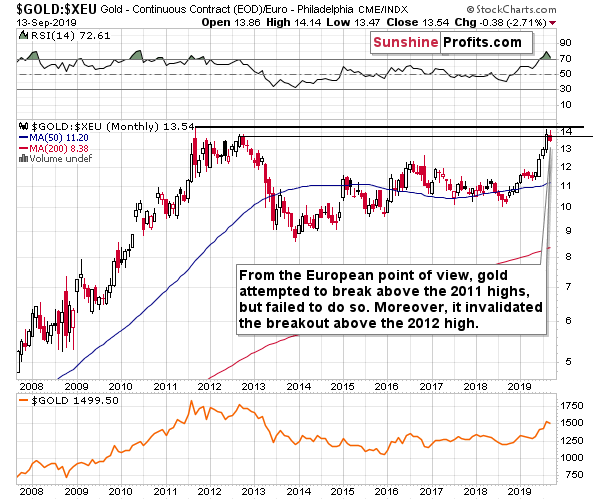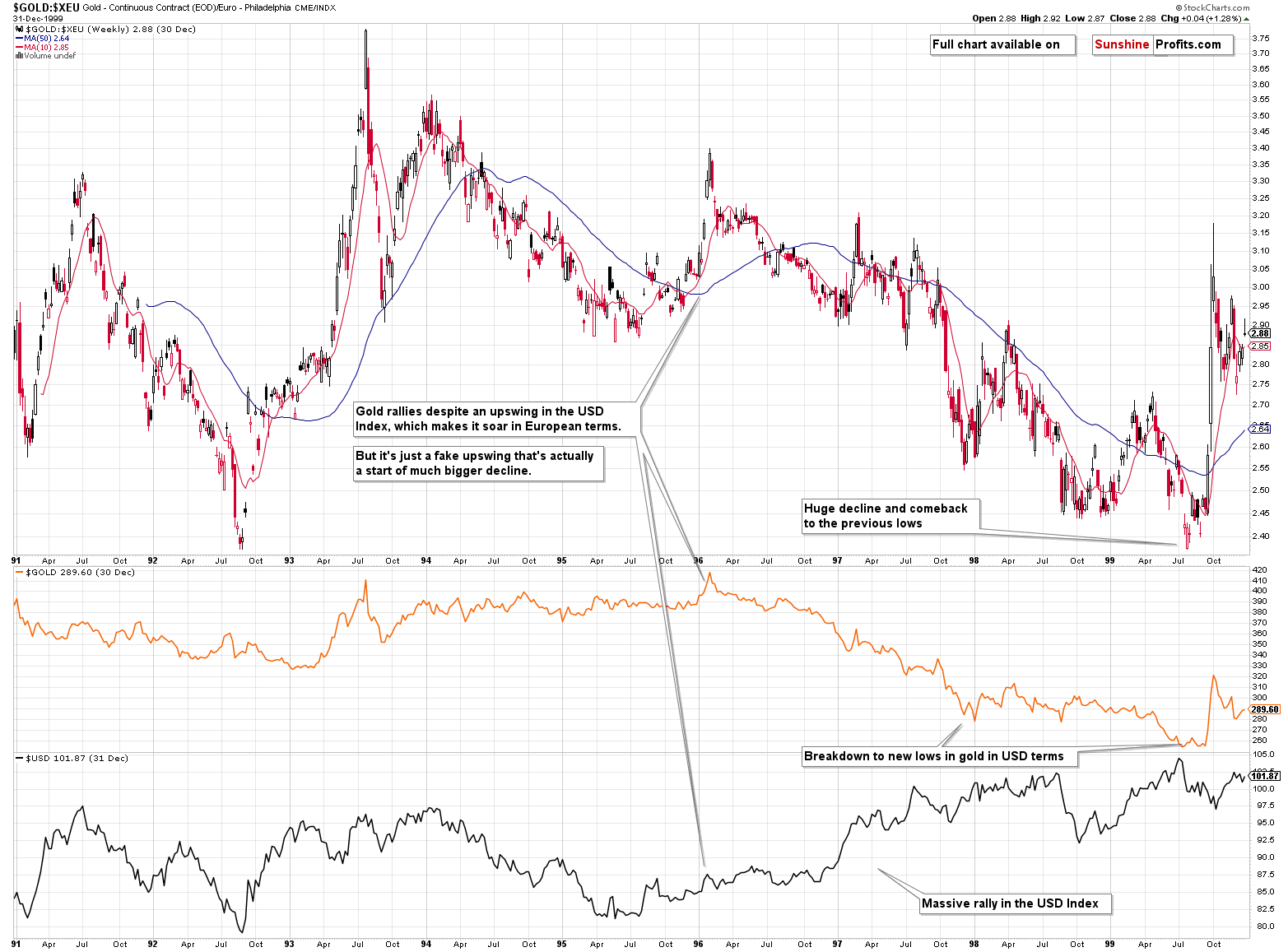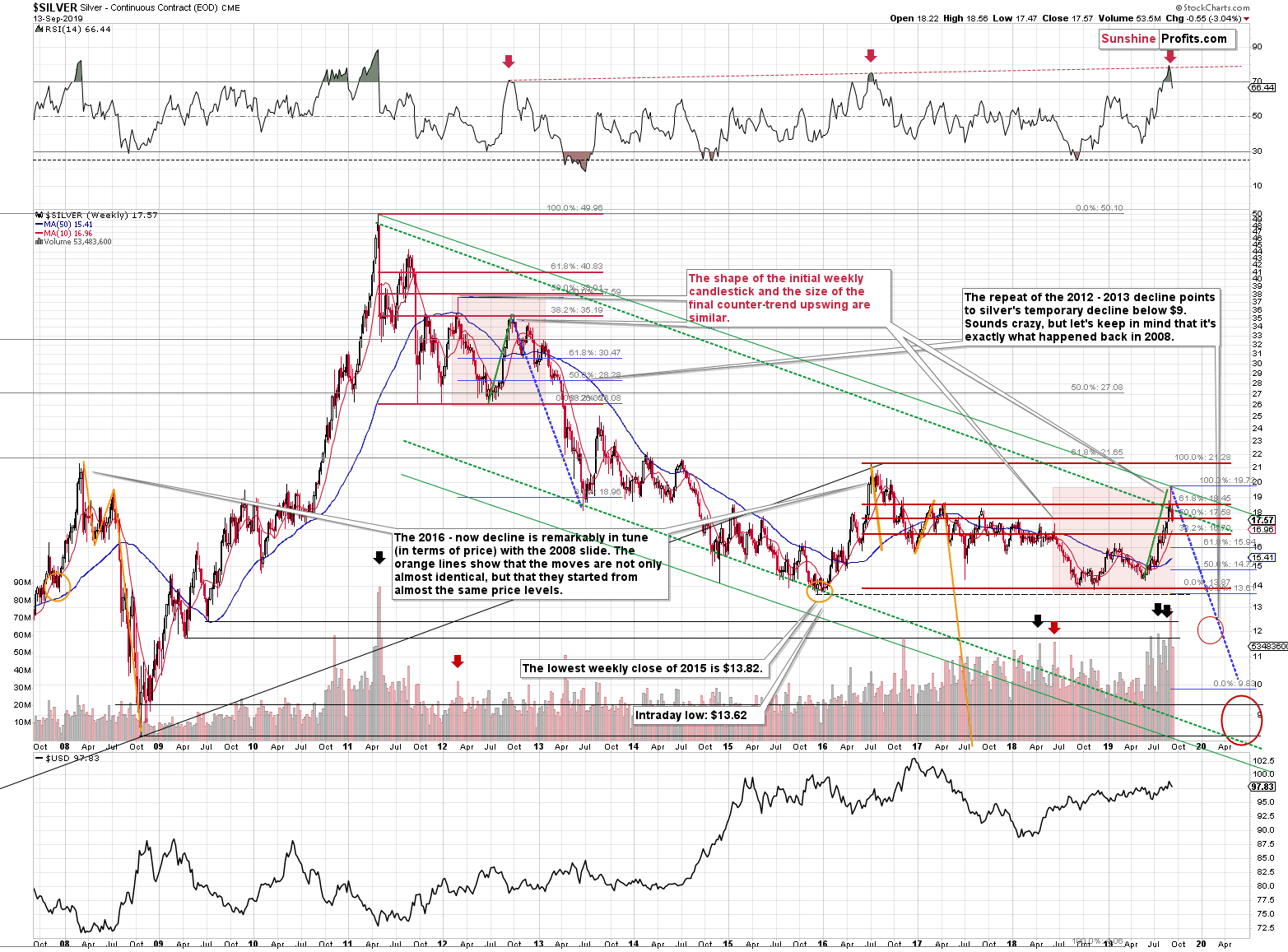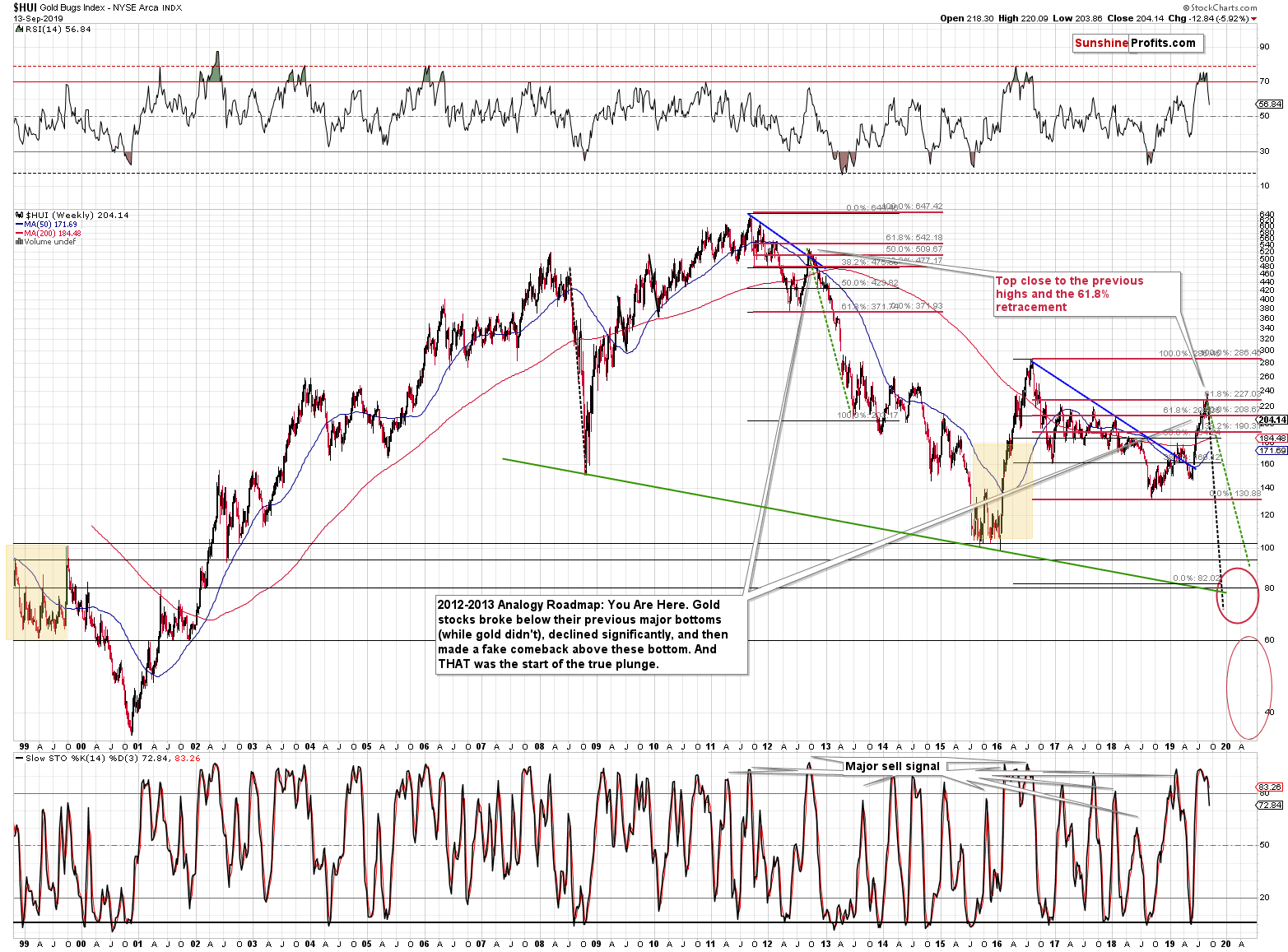Briefly: in our opinion, full (250% of the regular size of the position) speculative short position in gold, silver, and mining stocks are justified from the risk/reward point of view at the moment of publishing this Alert.
Gold and silver declined heavily on Friday, but they soared back up on Monday along with crude oil, likely due to the attack on the Saudi oil fields. But... Shouldn't it affect just crude oil prices? Why did gold and silver react? With the Fed's next rate decision just around the corner, is the market trying to tell us something important?
That's likely the case, but it's not likely what it appears at first sight. The panic buying of crude oil was likely to translate to higher gold and silver prices. Not necessarily directly, because these markets are not as related as many think, but indirectly. Chaos in the crude oil market - one of the most important markets - means chaos in general. This means that investors are likely to flock to safety, which means additional demand for gold and silver. So, there was nothing odd in the fact that precious metals moved higher. Now, what is meaningful is that despite this rally, both markets didn't invalidate their recent breakdowns. The geopolitical news is usually responsible for only short-term reactions, and once the dust settles, the markets resume their previous trends.
The Fed's interest rate decision is just around the corner, which means that the markets might be reluctant to move in a meaningful way before the decision is announced. The most likely scenario is the one in which the Fed cuts by 25 basis points, but some traders expect a deeper cut. This is unlikely as the Fed stated itself that the economic conditions remain favorable, and the central bank very rarely does something that would invalidate what it had just said. Consequently, the odds are that on average, the rate cut might be seen as hawkish (relative to expectations).
All in all, the recent breakdowns in the precious metals sector are likely correctly predicting what's going to happen next.
Gold, Silver and Breakdowns
Gold stocks had broken as the first, then gold followed. Even though the latter is not yet much below the line, it confirmed the breakdown by closing below it for three consecutive trading days. The weekly close serves as an additional confirmation. Silver broke based on Friday's decline.
As we mentioned above, these breakdowns were not invalidated even despite the attack on the Saudi oil fields.
Both: gold and silver moved back to the previously broken support line and verified it as resistance. This means that breakdowns' bearish implications remain intact. The gold trading suggestion here is to be out of the market or to short it.
From the long-term point of view, gold is after a major reversal and a weekly close below $1,500. The weekly close was just $0.50 below the $1,5k dam, but it's the little crack in it that makes the difference. With enough pressure, any dam can break. And small cracks lead to falls of massive constructions. The same is the case with gold. Gold rallied and reversed on huge volume - it even broke the record for the highest weekly volume that was ever recorded.
This shows just how big the pressure is. The RSI still above 70 tells us that the pressure remains immense and that the decline that we saw recently is next to nothing compared to what's to come. Gold's upswing testing the 2011 and 2012 lows was volatile, but these lows were not broken.
From the European point of view, the rally was even bigger.
Gold, Euroland and the Currencies Effect
Gold's price in terms of the euro has almost moved to its 2011 high. It did break above the 2012 high, but the move was very temporary and was invalidated this month. Given this invalidation and the RSI that's still above 70, it also seems that gold has further to fall in terms of the euro.
Ok, but if the USD Index rallies and gold declines, will gold decline in terms of the euro? If gold and the EUR/USD exchange rate move by the same percentage, the moves should cancel each other out, right?
This might be the case, but it's unlikely to be the case. In previous Alerts, we explained that the USD Index is likely within a massive long-term uptrend, just like it was in the first half of the 80s and the second half of the 90s. Gold declined during both periods and the latter is more similar to the current situation because this is the case when gold declined after a long consolidation, not after a new long-term high. The question is what happened to gold from the European point of view, during the second half of the 90s. Did it stay at the same level, even though gold declined in terms of the U.S. dollar?
Here's what happened:
Gold declined profoundly in both cases: priced both in American and in European currencies. In both cases gold first rallied, and the European rally was even sharper. We saw the same thing recently. However, in the months that followed the top (early 1996) gold declined and it declined more than the USD Index rallied. This resulted in sharply lower prices of gold also from the European point of view.
Gold made new lows in the USD terms and it only moved to the previous lows in the European terms. This is what we might expect in the coming months. Gold is likely to decline in terms of both the greenback and the euro, but the decline is likely to be more profound in case of the USD terms as rising USD Index will partially (!) offset some of the declines. Overall, it seems that the bearish forecast for gold is justified from both: American and European points of view. Simply put, much better gold buying opportunities await both the U.S. and European investors.
Silver and Gold Stocks
As far as silver and gold stocks' big pictures are concerned, the bearish signs remain intact.
Both markets have invalidated their temporary breakouts above the 61.8% Fibonacci retracement level based on the 2016 - 2018 declines. Silver additionally formed a huge reversal candlestick and it took place on enormous volume. This is a very strong bearish sign for the following weeks and months.
Before summarizing, we would like to once again quote the section with links to most important bearish factors that are currently in play:
Key Factors to Keep in Mind
Critical factors:
- The USD Index broke above the very long-term resistance line and verified the breakout above it. Its huge upswing is already underway.
- The USD's long-term upswing is an extremely important and bearish factor for gold. There were only two similar cases in the past few decades, when USD Index was starting profound, long-term bull markets, and they were both accompanied by huge declines in gold and the rest of the precious metals market
- Out of these two similar cases, only one is very similar - the case when gold topped in February 1996. The similarity extends beyond gold's about a yearly delay in reaction to the USD's rally. Also the shape of gold price moves prior to the 1996 high and what we saw in the last couple of years is very similar, which confirm the analysis of the gold-USD link and the above-mentioned implications of USD Index's long-term breakout.
- The similarity between now and 1996 extends to silver and mining stocks - in other words, it goes beyond USD, gold-USD link, and gold itself. The white metal and its miners appear to be in a similar position as well, and the implications are particularly bearish for the miners. After their 1996 top, they erased more than 2/3rds of their prices.
- Many investors got excited by the gold-is-soaring theme in the last few months, but looking beyond the short-term moves, reveals that most of the precious metals sector didn't show substantial strength that would be really visible from the long-term perspective. Gold doesn't appear to be starting a new bull market here, but rather to be an exception from the rule.
- Gold's True Seasonality around the US Labor Day points to a big decline shortly.
Very important, but not as critical factors:
- Long-term technical signs for silver, i.a. the analogy in terms of price to what we saw in 2008, shows that silver could slide even below $10.
- Silver's very long-term cycles point to a major reversal taking place right now and since the most recent move was up, the implications are bearish (this is also silver's technical sign, but it's so important that it deserves its own point)
- Long-term technical signs for gold stocks point to this not being a new gold bull market beginning. Among others, it's their long-term underperformance relative to gold that hint this is rather a corrective upswing within a bear market that is not over yet.
- Record-breaking weekly volume in gold is a strong sign pointing to lower gold prices
Important factors:
- Extreme volume reading in the SIL ETF (proxy for silver stocks) is an effective indication that lower values of silver miners are to be expected
- Silver's short-term outperformance of gold, and gold stocks' short-term underperformance of gold both confirm that the precious metals sector is topping here
- Gold topped almost right at its cyclical turning point, which makes the trend reversal more likely
- Copper broke below its head-and-shoulders pattern and confirmed the breakdown. The last time we saw something similar was in April 2013, when the entire precious metals sector was on the verge of plunging lower.
Moreover, please note that while there may be a recession threat, it doesn't mean that gold has to rally immediately. Both: recession and gold's multi-year rally could be many months away - comparing what happened to bond yields in the 90s confirms that.
Copper moved above the neck level of its head-and-shoulders pattern that's based on the intraday lows, but it didn't invalidate the analogous level based on the weekly closing prices, so we don't think it's justified to say that this bearish formation was invalidated at this time.
Summary
Summing up, the big decline in the precious metals sector appears to be finally underway as gold and silver are plunging even without a rallying USD Index. And the PMs' decline started right after the U.S. Labor Day, as we have described. Once the USDX takes off, it will likely serve as fuel to the fire-like decline that's already underway. The similarity to mid-90s continues to support much lower gold prices in the following months, and the True Seasonal patterns continues to favor lower gold prices in the following weeks. All in all, it seems that what we see right now is the beginning of the final stage of the prolonged decline in the precious metals sector that started in 2011. On a short-term basis, it seems that we might get some temporary strength once gold moves to about $1,330 - perhaps within the next few weeks.
As always, we'll keep you - our subscribers - informed.
To summarize:
Trading capital (supplementary part of the portfolio; our opinion): Full speculative short position (250% of the full position) in gold, silver, and mining stocks is justified from the risk/reward perspective with the following stop-loss orders and exit profit-take price levels:
- Gold: profit-take exit price: $1,332; stop-loss: $1,583; initial target price for the DGLD ETN: $39.87; stop-loss for the DGLD ETN: $25.17
- Silver: profit-take exit price: $14,62; stop-loss: $20,16; initial target price for the DSLV ETN: $32.96; stop-loss for the DSLV ETN: $11.67
- Mining stocks (price levels for the GDX ETF): profit-take exit price: $22.62; stop-loss: $32.37; initial target price for the DUST ETF: $17.28; stop-loss for the DUST ETF $5.48
In case one wants to bet on junior mining stocks' prices (we do not suggest doing so - we think senior mining stocks are more predictable in the case of short-term trades - if one wants to do it anyway, we provide the details), here are the stop-loss details and target prices:
- GDXJ ETF: profit-take exit price: $30.32; stop-loss: $45.42
- JDST ETF: profit-take exit price: $38.36 stop-loss: $11.26
Long-term capital (core part of the portfolio; our opinion): No positions (in other words: cash)
Insurance capital (core part of the portfolio; our opinion): Full position
Whether you already subscribed or not, we encourage you to find out how to make the most of our alerts and read our replies to the most common alert-and-gold-trading-related-questions.
Please note that the in the trading section we describe the situation for the day that the alert is posted. In other words, it we are writing about a speculative position, it means that it is up-to-date on the day it was posted. We are also featuring the initial target prices, so that you can decide whether keeping a position on a given day is something that is in tune with your approach (some moves are too small for medium-term traders and some might appear too big for day-traders).
Plus, you might want to read why our stop-loss orders are usually relatively far from the current price.
Please note that a full position doesn't mean using all of the capital for a given trade. You will find details on our thoughts on gold portfolio structuring in the Key Insights section on our website.
As a reminder - "initial target price" means exactly that - an "initial" one, it's not a price level at which we suggest closing positions. If this becomes the case (like it did in the previous trade) we will refer to these levels as levels of exit orders (exactly as we've done previously). Stop-loss levels, however, are naturally not "initial", but something that, in our opinion, might be entered as an order.
Since it is impossible to synchronize target prices and stop-loss levels for all the ETFs and ETNs with the main markets that we provide these levels for (gold, silver and mining stocks - the GDX ETF), the stop-loss levels and target prices for other ETNs and ETF (among other: UGLD, DGLD, USLV, DSLV, NUGT, DUST, JNUG, JDST) are provided as supplementary, and not as "final". This means that if a stop-loss or a target level is reached for any of the "additional instruments" (DGLD for instance), but not for the "main instrument" (gold in this case), we will view positions in both gold and DGLD as still open and the stop-loss for DGLD would have to be moved lower. On the other hand, if gold moves to a stop-loss level but DGLD doesn't, then we will view both positions (in gold and DGLD) as closed. In other words, since it's not possible to be 100% certain that each related instrument moves to a given level when the underlying instrument does, we can't provide levels that would be binding. The levels that we do provide are our best estimate of the levels that will correspond to the levels in the underlying assets, but it will be the underlying assets that one will need to focus on regarding the signs pointing to closing a given position or keeping it open. We might adjust the levels in the "additional instruments" without adjusting the levels in the "main instruments", which will simply mean that we have improved our estimation of these levels, not that we changed our outlook on the markets. We are already working on a tool that would update these levels on a daily basis for the most popular ETFs, ETNs and individual mining stocks.
Our preferred ways to invest in and to trade gold along with the reasoning can be found in the how to buy gold section. Additionally, our preferred ETFs and ETNs can be found in our Gold & Silver ETF Ranking.
As a reminder, Gold & Silver Trading Alerts are posted before or on each trading day (we usually post them before the opening bell, but we don't promise doing that each day). If there's anything urgent, we will send you an additional small alert before posting the main one.
Thank you.
Sincerely,
Przemyslaw Radomski, CFA
Editor-in-chief, Gold & Silver Fund Manager


